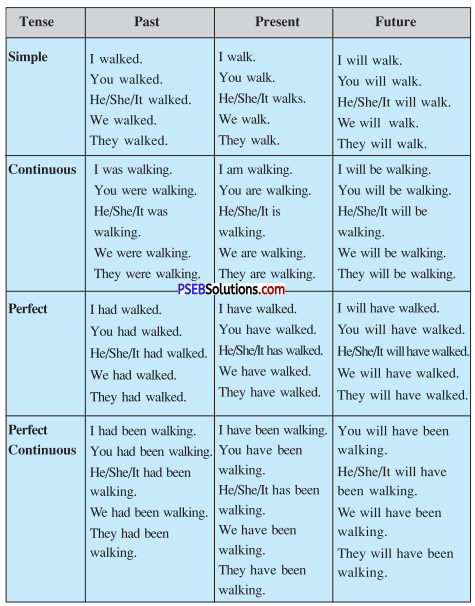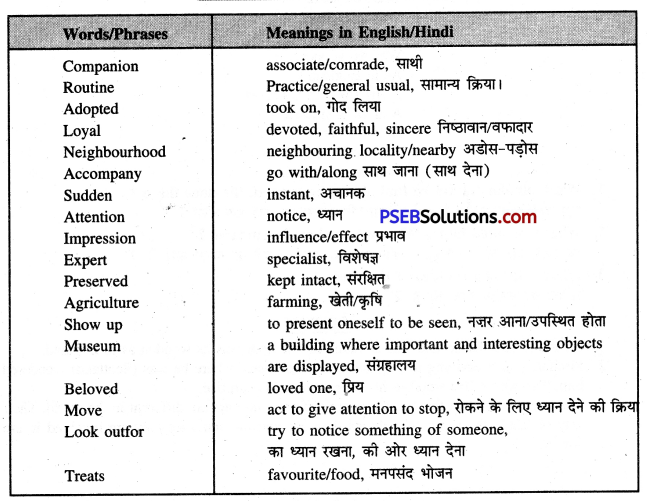Punjab State Board PSEB 7th Class English Book Solutions Chapter 8 Hachiko-The World’s Most Loyal Dog Textbook Exercise Questions and Answers.
Class 7th English Solutions Chapter 8 Hachiko-The World’s Most Loyal Dog Question Answers
Hachiko-The World’s Most Loyal Dog Class 7 Questions and Answers
Activity 1.
Look up the following words in a dictionary. You should seek the following information about the words and put them in your WORDS notebook.
1. Meaning of the word as used in the story (adjective/noun/verb, etc.)
2. Pronunciation (The teacher may refer to the dictionary or the mobile phone for correct . pronunciation.)
3. Spellings
| Akita | neighborhood | agriculture | accompany |
| routine | receive | hemorrhage | show up |
| beloved | employees | devoted | museum |
Vocabulary Expansion
Activity 2.
Write antonyms of the following words.
1. respect — disrespect
2. affection — hatred/hate
3. usual — unusual
4. followed — led
5. lonely — crowded/populous
6. presence — absence
7. master — servant
8. loyalty — disloyalty
![]()
Activity 3.
Look at the following words in the grid. Identify the base words and prefixes and suffixes added to them. Write the base word and the prefix/suffix in the space given for each.

Answer:

Learning to Read and Comprehend
Activity 4.
Answer the following questions based on the above story.
Question 1.
Who was Hachiko ?
हचीको कौन था ?
Answer:
Hachiko was a very faithful and loyal dog. He was true companion.
Question 2.
What was his breed ?
उसकी प्रजाति (ब्रीड) कौन – सी थी?
Answer:
His breed was Akita.
Question 3.
When was he born ?
वह कब पैदा हुआ ?
Answer:
He was born on November 10, 1923.
![]()
Question 4.
Who adopted him ?
उसे किसने गोद लिया ?
Answer:
Professor Hidesburo adopted him, first.
Question 5.
Where did Ueno teach ?
यूनो कहाँ पढ़ाते थे ?
Answer:
Ueno tought in the Agriculture Department of the Tokyo Imperial University.
Question 6.
What was their routine ?
अनकी दिनचर्या क्या थी ?
Answer:
Everyday morning they would walk to the Shibuya Railway Station. At 3 p.m. the professor would return and the dog would go to the railway station to accompaning him back home.
Question 7.
What happened to the Professor one day ?
एक दिन प्रोफैसर को क्या हुआ ?
Answer:
One day the Professor died because of a sudden brain harmorrhage.
Question 8.
What did Hachiko do after Ueno died ?
हचीको ने यूनो की मृत्यु के बाद क्या किया ?
Answer:
He would daily go to the railway station at 3 p.m. to receive his master.
Question 9.
Who adopted Hachiko after Ueno died ?
यूनो की मृत्य के बाद हचीको को किसने गोद लिया ?
Answer:
After Ueno died his former gardener, kujaburo kobayashi adopted Hachiko.
Question 10.
Who went to see Hachiko after coming to know about his routine ?
हचीको की दिनचर्या का पता चलने पर कौन उसे देखने गया ?
Answer:
Hirokichi Saito who was an expert on the Akita breed of dogs, went to see Hachiko.
Activity 5.
Choose the right answer and write in the given space.
Answer:
1. Hachiko was a very loyal/disloyal dog — loyal
2. Shibuya is a place near/away from Tokyo — near
3. Ueno always came back on the 3/4pm train. — 3 p.m.
4. Hachiko would wait for Ueno at the station/home. — Station
5. Hachiko lived for 11/13 years. — Station
![]()
Activity 6.
Discuss and answer the following questions.
Question 1.
Why did people make statues of Hachiko ?
Answer:
People made the statues of Hachiko to make him immortal for his loyalty and faithfulness.
Question 2.
Why do you think Saito wiped a tear from his cheek?
Answer:
Saito was an expert of the Akita breed of dogs. He read the sad hard of Hachiko.
Learning Language
Conjugation of Verbs
Verb conjugation का अर्थ है कि कोई verb वाक्य में Person, Tense, Number या Mood में परिवर्तन के साथ कैसे बदलता है।
Person.
In English, we have six different persons -first-person singular (I), second-person singular (you), third-person singular (he/she/it/one), first-person plural (we), second-person plural (you), and third-person plural (they). We must conjugate a verb for each person. The verb to be is a particularly notable verb for conjugation because it is an irregular verb.
![]()
Conjugation of the verb ‘to be’ (is/am/are)
| Person | Tense | ||
| Past | Present | Future | |
| I | was | am | will be |
| you | were | arc | will be |
| he /she/it | was | is | will be |
| we | were | are | will be |
| they | were | are | will be |
Tense के अनुसार भी Verb के रूप में बदलाव आता है। इसे समझने के लिए नीचे दी गई तालिका अध्ययन of करें इसमें Verb ‘walk’ के माध्यम से verb की Conjugation को समझाया गया है।
Conjection

Activity 7.
Select the correct form of the verb given in the options and fill it in the given blank.
Question 1.
Meena …………………_since morning.
(a) has been dancing
(b) is dancing
(c) dances
Answer:
(a) has been dancing.
Question 2.
I ………….. in the garden when she came to my house.
(a) am working
(b) was working
(c) worked
Answer:
(b) was working.
![]()
Question 3.
I ………………….. in the factory for two hours when Seema called.
(a) have been working
(b) was working
(c) had been working
Answer:
(c) had been working.
Question 4.
I ……………… my exam this time next week.
(a) will be writing
(b) will write
(c) would be writing
Answer:
(a) will be writing.
Question 5.
They had already left when I …………. home.
(a) reached
(b) have reached
(c) had reached
Answer:
(a) reached.
Question 6.
If you are hungry, I ………….. ……. you something to eat.
(a) am getting
(b) will get
(c) will be getting
Answer:
(b) will get.
Question 7.
Saavan ………….. songs.
(a) writes
(b) write
(c) written
Answer:
(a) writes.
Question 8.
We …………. often go to the garden.
(a) don’t
(b) doesn’t
(c) haven’t
Answer:
(a) don’t
![]()
Question 9.
We …………… to Delhi last week.
(a) went
(b) have gone
(c) had gone.
Answer:
(a) went.
Question 10.
The children …………………. a splendid performance.
(a) gives
(b) give
(c) gave.
Answer:
(b) give.
Learning to Listen
Activity 8
Your teacher will read out a dialogue. Listen to the dialogue and answer the following questions.
Question 1.
Which movie do these people plan to watch ?
(a) The Lion King
(b) The Two Towers
(c) Singham
(d) Mowgli
Answer:
(d) Mowgli.
Question 2.
When do they plan to watch the movie ?
(a) on the weekend
(b) tomorrow
(c) today evening
(d) next Friday
Answer:
(b) tomorrow.
Question 3.
Where do they plan to meet ?
(a) at the Subway close to the mall
(b) in front of the mall
(c) at the coffee shop close to the mall
(d) at home
Answer:
(a) at the Subway close to the mall.
![]()
Question 4.
What time do they plan to meet ?
(a) at 7:30 pm
(b) at 12 noon
(c) at 1pm
(d) at 3:45 pm
Answer:
(c) at 1pm.
Learning to Speak
Activity 9
Look at the picture given below and describe, in your own words, what is happening.

Answer:
1. There are two furry dogs in the picture.
2. One dog is big, the other is small.
3. The big dog is white with a black shade in colour.
4. The small dog is also white but it has a shade of grey colour on his body.
5. Both the dogs have belt- round their necks. This suggests they are pet ones.
6. The colours of their belt is red and blue respectively.
7. The big dog looks furious. But the little one appears to be playful.
8. The little dog is carrying a twig in his mouth.
Learning to Write
Activity 10
Write a letter to your cousin telling her/him about the new pet (a dog or a cat) you have adopted.
You should write in the letter
what pet you have adopted
what you have named it
how you play with your pet
how it has changed your life or routine
15, New Colony,
Phagwara.
14 March, 20…….
Dear Vipin,
You will be glad to know that I have adopted a day. It is a stray dog. I have named it Tommy. It is like a small toy. It takes milk, bread and meat. It plays with us. We throw the ball away and Tommy runs after it and return with the ball to us. As it gets up early in the morning, it has changed my life. We together go for a walk in the morning and in the evening. We run a race which I never win. I hope you will be happy to meet it.
Your loving brother,
Rahul.
![]()
Learning to Use Language
Activity 11
Browse the following sites for more information and also to watch a film on Hachiko. After going through the sites, write all the new information you get on Hachiko
(The teacher must arrange the use of the Internet for students in the computer lab.)
नोट-अध्यापक की सहायता से स्वयं करें।
Comprehension Of Passages
Read the following passages carefully and answer the question that follow each.
(1) Hachiko, the dog was more than just a pet. He was a true companion. He was very loyal and faithful. Every day, Hachiko would greet his human friend, his master, a routine the faithful dog kept, even after his owner’s death. A golden-brown of Akita breed, Hachiko was born on November 10, 1923 in a farm in Japan. In 1924, Professor Hidesaburo Ueno adopted Hachiko and brought him to live with him in Shibuya, a small town in the neighbourhood of Tokyo.
Professor Hidesaburo Ueno taught in the Agriculture Department of Tokyo Imperial University. Every morning the professor would walk to the Shibuya railway station and Hachiko would also go with him to see his master take the train to work. After finishing the day’s classes, the professor would take the train back and return to the station at 3 pm.
1. Who was Hachiko ? Give his any two good qualities.
हचिको कौन था ? उसके कोई दो अच्छे गुण लिखो।
2. Where did Professor Ueno live ?
प्रोफैसर यूनो कौन था ?
3. Choose true and false statements and write them in your note book. . .
(a) The dog followed his routine even after his master’s death.
(b) The professor returned to his home town at 3 p.m. daily.
4. Complete the sentence according to the meaning of the passage.
(a) Professor Ueno taught in the ……………
(b) Hachiko, the dog was more than …….
5. Match the words with their meanings.
| (a) faithful | comeback |
| (b) return | to take turn |
| loyal |
Answer:
1. Hachiko was a pet dog. He was a true companion. He was very loyal and faithful.
2. Professor Ueno lived in Shibuya, a small town in the neighbourhood of Tokyo.
3.
(a) True
(b) True
4.
(a) Professor Ueno tought in the Agriculture Department of Tokyo University.
(b) Hachiko the dog was more than just a pet.
5.
(a) faithful-loyal
(b) return-come back.
![]()
(2) The master and Hachiko kept this schedule until one sad day in May 1925 Professor Veno suffered a sudden brain hemorrhage while teaching and passed away. That day, Hachiko showed up at 3 pm as usual, but his beloved master never came back. Hachiko returned the next day at the same time, hoping that Veno would be there to meet him. Of course, the professor did not return, but his loyal Hachiko never gave up hope.
Hachiko was at Shibuya Station the next day again at 3 pm, then the day after, and the day after that. Soon, the lonely dog began to draw the attention of the other passengers.
At first, the station workers were not friendly with the dog, but after some time, people started looking out for him. Even the station employees would bring food and treats for the devoted dog and sometimes sit and keep him company.
1. How did Ueno die?
यूनो की मृत्यु कैसे हुई ?
2. What change did the dog bring about in the station workers ?
कुत्ते ने स्टेशन कर्मचारियों में क्या परिवर्तन लाया ?
3. Choose true and false statements and write them in your note book.
(a) The dog lost his hope as the days passed.
(b) Ueno died in May 1925.
4. Complete the sentence according to the meaning of the passage.
(a) Hachiko showed up at …………… as usual to the dog.
(b) The station employees would bring …………. for the devoted dog.
5. Match the words with their meanings.
| (a) devoted | died |
| (b) passed away | sincere |
| appeared |
Answer:
1. Ueno while teaching suffered a sudden brain haemorrhage and died.
2. The station workers who were not friendly with him, stated looking out for him. They started giving him food and their company.
3.
(a) False
(b) True.
4.
(a) Hachiko showed up at 3pm as usual.
(b) The station employees would bring food and treats for the devoted dog.
5.
(a) devoted — sincere
(b) Passed away — died.
3. One of Professor Ueno’s former students, Hirokichi Saito was an expert on the Akita breed of dogs. He came to know of Hachiko and his routine. He decided to take the train to Shibuya to see if Hachiko would still be waiting.
When Saito arrived at the station, he saw Hachiko there waiting for his master. He wiped a tear from his cheek. He waited for Hachiko to make the next move. After a long wait, Hachiko stood up and went from there. Saito followed the dog from the station to the home of Ueno’s former gardener, Kuzaburo Kobayashi who had adopted Hachiko but Hachiko waited only for Ueno.
For nearly a decade, after his master passed away, the dog continued to show up at the same spot every day until Hachiko died at the age of eleven on March 08, 1935. The dog became a symbol of loyalty in Japan – and now for the world.
1. Who was Hirokichi Saito ?
हीरोकीची सेंटो कौन था ?
2. He wiped a tear from his cheek ? What does this line show ?
उसने कुत्ते के गाल से एक आँसू पोंछा। यह पंक्ति क्या दर्शाती है? ।
3. Choose true and false statements and write them in your note book.
(a) After the death of Ueno his former gardner adopted Hachiko.
(b) Hachiko died at the age of thirty-five.
4. Complete the sentence according to the meaning of the passsage.
(a) After a long wait. Hachiko stood up and ………
(b) The dog become a ……………. in Japan.
5. Match the words with their meanings.
| (a) decade | took on |
| (b) adopted | a period of ten years died. |
| died |
Answer:
1. Hirokichi Saito was a former student of professor Ueno. He was an expert on the Akita breed of dogs.
2. This line show that Hachiko was very sad at heart after his master’s death.
3.
(a) True
(b) False.
4.
(a) After a long wait Hachiko Stood up and went from these.
(b) The dog became a symbol of loyalty in Japan.
5.
(a) decade – a period of ten years
(b) adopted – took on
![]()
Use Of Words/Phrases In Sentences
1. Loyal (devoted, sincere) —
Should be loyal to the country.
हमें देश के प्रति निष्ठावान होना चाहिए।
2. Faithful (loyal, sincere) —
A dog is a faithful animal.
3. True (firm) —
He is true to his word promise.
वह अपने वचन का पक्का है। I
4. Recieve (to get) —
I received your letter yesterday.
मुझे कल तुम्हारा पत्र मिला।
5. Show up (to appear, to present) —
You must show up in the school ground at 9. am.
तुम्हें प्रातः 9 बजे स्कलू ग्राऊंड में पहुंच जाना चाहिए।
6. Passedaway (died) —
My grandmother passed away last month.
मेरी दादी पिछले महीने चल बसे।
7. Look out (take care) —
Look out ! The train has started.
देखो! रेलगाड़ी चल चुकी है।
8. Expert (specialist) —
My uncle is an Expert on birds.
मेरे चाचा जी पंछियों के माहिर हैं।
Word Meanings

Hachiko-The World’s Most Loyal Dog Summary in Hindi
Hachiko, the dog ……….. passed away.
हचीको (Hachiko) नामक कुत्ता पालतू होने से कहीं अधिक महत्त्व रखता है। वह एक सच्चा साथी था। वह बहुत ही निष्ठावान तथा वफादार था। हचीको प्रतिदिन अपने मानव मित्र जो इसका मालिक था, का अभिवादन करता था। यही दिनचर्या वफादार कुत्ते ने अपने मालिक की मृत्यु के बाद भी जारी रखी।
सुनहरी भूरी, अकीता प्रजाति (Akita bread) के हचीको का जन्म 10 नवम्बर, 1923 को जापान के एक खेत में हुआ। 1924 में प्रोफेसर एजाबुरो यूनो (Professor Hidesaburo Ueno) ने हचीको को गोद ले लिया और उसे टोक्यो के एक छोटे से शहर शिबुआ (Shibuya) में ले आये। प्रोफ़ेसर एज़ाबुरो यूनो टोक्यो इम्पीरियल यूनिवर्सिटी के कृषि विभाग में पढ़ाते थे। प्रत्येक सुबह प्रोफ़ेसर शिबुआ स्टेशन तक टहलते हुए जाते थे और हचीको भी उनके साथ जाता था तकि वह अपने मालिक को काम पर जाते हुए ट्रेन पकड़ते देखे।
![]()
अपने दिन की कक्षाओं को समाप्त करके प्रोफेसर वापिसी के लिए ट्रेन पकड़ते और 3 बजे स्टेशन पर पहुंचते। हचीको स्टेशन पर पहुंच जाता और प्रोफेसर का इंतजार करता और उनके साथ टहलता हुआ वापिस घर आता। जोड़ी की प्रतिदिन की यही दिनचर्या थी। हर रोज़ हचीको एक ही समय पर अपने मालिक को लेने पहुंच जाता। मालिक और हचीको ने अपना कार्यक्रम तब तक जारी रखा जब तक एक अशुभ दिन मई, 1925 को प्रोफेसर यूनो की अचानक ब्रेन हेमेज से मृत्यु नहीं हो गई।
That day …………. …….. still be waiting.
उस दिन, हचीको हमेशा की भांति 3 बजे आ गया, परन्तु उसका प्रिय मालिक कभी वापिस नहीं आया। हचीको अगले दिन उसी समय इस आशा के साथ वापिस आया कि यूनो उसे वहां मिलेंगे। निःसंदेह प्रोफेसर कभी वापिस नहीं आए, परन्तु उनके वफ़ादार हचीको ने कभी आशा नहीं छोड़ी।
दिन बीतते गए और हचीको प्रतिदिन 3 बजे शिबुआ स्टेशन पर आ जाता था। शीघ्र ही अन्य यात्रियों का ध्यान इस अकेले डॉग (कुत्ते) की ओर जाने लगा। पहले पहल स्टेशन के कर्मचारी कुत्ते के साथ मित्रवत् नहीं थे परन्तु कुछ समय के बाद उसकी ओर ध्यान देने लगे। यहाँ तक कि स्टेशन के कर्मचारी उस वफ़ादार कुत्ते के लिए भोजन खाने के लिए उसके मनचाहे पदार्थ लाने लगे। कभीकभी वे उसके पास बैठ कर उसका साथ देते। दिन हफ्तों में, फिर महीनों में, फिर सालों में बदलें और हचीको, हर रोज इंतजार करने आता। उसकी उपस्थिति ने शिबुआ के स्थानीय लोगों पर ऐसा प्रभाव छोड़ा कि वह उनके लिए निष्ठा और विश्वास का एक प्रतीक बन गया, जैसे वह उनका नायक हो।
प्रोफेसर यूनो का एक पुराना छात्र हिरोकिची सैटो (Hirokichi Saito), अकीता नस्ल के कुत्तों का विशेषज्ञ था। उसे हचीको और उसकी दिनचर्या का पता चला। उसने निर्णय किया कि वह ट्रेन से शिबुआ जाएगा और देखेगा कि क्या हचीको अभी भी इंतज़ार कर रहा है।
When Saito arrived ……………………. go to Japan.
जब सैटो स्टेशन पहुंचा तो उसने हचीको को अपने मालिक का इंतजार करते देखा। उसने उसके गाल पर एक आंसू को पोंछा। उसने हचीको के अगले कदम की प्रतीक्षा की। एक लम्बे इंतजार के बाद हचीको उठ खड़ा हुआ और वहाँ से चला गया। सैटो ने कुत्ते का स्टेशन से उस घर तक पीछा किया जो यूनो के पुराने माली कुजाबुरो कोबायशी (Kuzaburo Kobayashi) था जिसने हचीको को गोद ले लिया था।
परन्तु हचीको यूनो का ही इंतजार करता था।अपने मालिक की मृत्यु के बाद लगभग दस वर्ष तक हचीको (कुत्ता) उसी जगह पर प्रतिदिन दिखाई देता रहा, जब तक कि 11 वर्ष की आयु में 8 मार्च 1935 को उसकी मृत्यु नहीं हो गई। (कुत्ता) डॉग जापान में वफ़ादारी का प्रतीक बन गया और अब पूरे विश्व में बन गया है।डॉग के प्रति आदर और प्यार के कारण लोग हचीको को “चुकेन हचीको” (Chukan Hachiko) पुकारने लगे।
इसका अर्थ है-वफ़ादार कुत्ता हचीको। हचीको की याद में एक बुत्त बनाया गया है शिबुआ में तथा एक उस स्थान पर जहाँ वह अपने मालिक यूनो को काम से वापिस आने पर मिलता था। हचीको के मृत शरीर को (म्यूजियम) संग्रहालय में संरक्षित करके रखा गया है। हां, यदि आप जापान जाएं तो आप अब भी हचीको को मिल सकते हैं।
Retranslation Of Isolated Sentences
1. He was a true companion.
वह एक सच्चा साथी था।
2. Hachiko wot his human friend his master.
हचीको अपने मानव मित्र अर्थात् अपने मालिक का अभिवादन करता था।
3. Hachiko was born on November 10, 1923.
हचीको का जन्म 10 नवम्बर 1923 को हुआ।
4. Every morning the professor would walk to the Shibuya railway station.
प्रत्येक सुबह प्रोफेसर शिबुआ स्टेशन तक टहलते हुए जाते थे।
5. Hachiko would also go with him.
हचीको भी उनके साथ जाता था।
6. The pair followed the same routine every day.
जोड़ी की प्रतिदिन की यही दिनचर्या थी।
7. But his beloved master never came back.
परन्तु उसका प्रिय मालिक कभी वापिस नहीं आया।
8. Even the station employees would bring food for the devoted dog.
यहाँ तक कि स्टेशन के कर्मचारी भी उस वफादार कुत्ते के लिए भोजन लाते थे।
![]()
9. His presence made a great impression on the local people of Shibuya.
उसकी उपस्थिति ने शिबुआ के स्थानीय लोगों को बहुत अधिक प्रभावित किया।
10. Yes, you can still meet Hachiko if you go to Japan
हां, यदि आप जापान जाएं तो आप अब भी हचीको से मिल सकते हैं।
English Guide for Class 7 PSEB Prose
